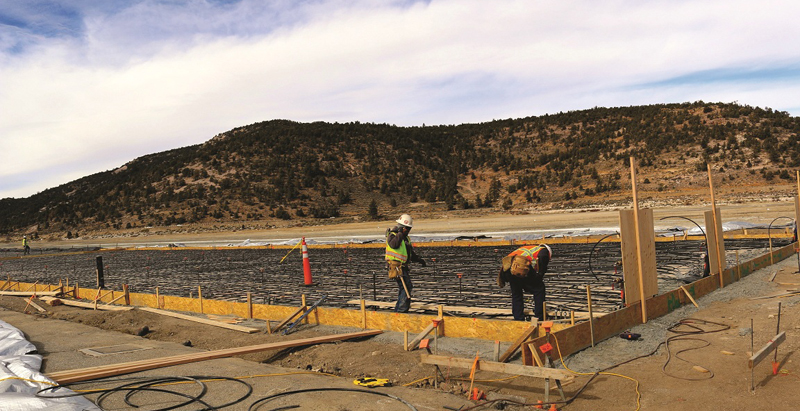When most people think of radiant heat or hydronic snowmelt, the usual applications are warm floors, heated sidewalks and snow-free driveways. Viega Radiant Design Services in Nashua, NH, has designed and quoted thousands of projects like those, but occasionally they receive requests for assistance with out-of-the-box projects.
The Big Bear Area Regional Wastewater Agency (BBARWA) in Big Bear, CA, contacted Viega Radiant Design Services with a project that needed an innovative solution. A byproduct of the water treatment process is sludge, composed of 25% solids and 75% water. Since the sludge must be hauled by truck to an off-site disposal area, BBARWA needed a way to reduce the water content and weight of the sludge, making it less expensive to haul. BBARWA tried several different methods to dry the sludge with only marginal success, so they decided to devise a new system that would be more effective, more efficient and would reduce the odor complaints.
Viega Radiant Design Services worked on the specifics of the slab heating system design, focusing on what would be required to generate enough heat from the slab to meet the sludge-drying objectives. Viega design engineers used finite element analysis (FEA) to determine the optimum tubing size, spacing and install-depth in the slab based on the water temperature supplied from the diesel generator’s exhaust. Due to the shape and size of the 315- by 60-foot heated slab, it was clear that this project was an excellent application for Viega’s revolutionary Viega Climate Mat® system.
Since the facility produces its own electricity using three natural gas generators, the water flowing through the slab would be heated with a heat exchanger in one of the generator’s exhaust, making it an efficient co-generation system. Within the first year alone, the new system saved approximately $200,000 in transportation and fuel costs.
Viega Climate Mat® system
The contractors were impressed with the speed and ease of installation of the Viega Climate Mat and appreciated the support provided by Viega throughout the entire process, from design to installation.
“Anything you said you could do, you did it,” said Plant Manager Fred Uhler. “They were topnotch guys from the sales staff, to the design support. They were excited about the project. It’s great to work with people like that.”
Once the covered drying bed building was completed, the system went into operation in June 2014. Within a few months, it became clear that this unique application of radiant heating was a resounding success. In 2015, Uhler reported that the system was performing beyond expectations and even better in the low-humidity winter months.
“This system is self-operational, and I’ve had zero maintenance issues with it from Viega’s side of things,” Uhler said. “It couldn’t be any better.”
Additionally, the project received the California Water Association Desert Mountain Award for Innovation.
While conventional radiant heating and snow melting projects are everyday business for the Viega team, projects like the Big Bear Area Regional Wastewater Agency covered drying bed are prime examples of how Viega can design and deliver innovative solutions that improve lives, reduce energy usage and help protect the environment.
For more information on Viega system solutions, visit Viega.us.
Viega
800.976.9819
insidesales@viega.us
www.viega.us
Related Stories
| Aug 11, 2010
New York Mayor Bloomberg opens nation's first multi-story green industrial facility and announces new green manufacturing plant at Brooklyn Navy Yard
Mayor Michael R. Bloomberg, Deputy Mayor for Economic Development Robert C. Lieber, and Brooklyn Navy Yard Development Corporation Chairman Alan Fishman and President Andrew H. Kimball today opened the Perry Avenue Building, the nation's first multi-story green industrial facility at the Brooklyn Navy Yard. Mayor Bloomberg also announced the creation of Duggal Greenhouse, a 60,000-square-foot LEED Platinum certified facility.
| Aug 11, 2010
ASHRAE introduces building energy label prototype
Most of us know the fuel efficiency of our cars, but what about our buildings? ASHRAE is working to change that, moving one step closer today to introducing its building energy labeling program with release of a prototype label at its 2009 Annual Conference in Louisville, Ky.
| Aug 11, 2010
USGBC considering LEED for Data Centers program
In a blog post this morning on Earth2Tech, Justin Moresco writes that the U.S. Green Building Council is giving strong consideration to developing a version of its LEED green building rating system for data centers.
| Aug 11, 2010
10 tips for mitigating influenza in buildings
Adopting simple, common-sense measures and proper maintenance protocols can help mitigate the spread of influenza in buildings. In addition, there are system upgrades that can be performed to further mitigate risks. Trane Commercial Systems offers 10 tips to consider during the cold and flu season.
| Aug 11, 2010
Jacobs, Holder Construction top BD+C's ranking of the nation's 50 largest industrial building contractors
A ranking of the Top 50 Industrial Contractors based on Building Design+Construction's 2009 Giants 300 survey. For more Giants 300 rankings, visit http://www.BDCnetwork.com/Giants
| Aug 11, 2010
AECOM, Arup, Gensler most active in commercial building design, according to BD+C's Giants 300 report
A ranking of the Top 100 Commercial Design Firms based on Building Design+Construction's 2009 Giants 300 survey. For more Giants 300 rankings, visit http://www.BDCnetwork.com/Giants
| Aug 11, 2010
Turner Building Cost Index dips nearly 4% in second quarter 2009
Turner Construction Company announced that the second quarter 2009 Turner Building Cost Index, which measures nonresidential building construction costs in the U.S., has decreased 3.35% from the first quarter 2009 and is 8.92% lower than its peak in the second quarter of 2008. The Turner Building Cost Index number for second quarter 2009 is 837.
| Aug 11, 2010
AGC unveils comprehensive plan to revive the construction industry
The Associated General Contractors of America unveiled a new plan today designed to revive the nation’s construction industry. The plan, “Build Now for the Future: A Blueprint for Economic Growth,” is designed to reverse predictions that construction activity will continue to shrink through 2010, crippling broader economic growth.







